The Customer Journey Map: Understanding the Buyer’s Process
Did you know that 63% of customers are eager to share more with companies that offer great experiences? This shows how crucial it is to understand the buyer’s journey. It helps in building a shared understanding in a company and keeps customers coming back.
A customer journey map is key for seeing how customers interact and feel at different points with a brand. It uncovers what customers do on purpose, why they do it, and what hurts them. It also shows why they pick one company over another. By making a visual story of these interactions, companies learn a lot about what customers need and think.
Key Takeaways
- A customer journey map shows every interaction a customer has with a service, brand, or product.
- By mapping the customer journey, companies can learn what customers think and make important changes to products or services.
- Creating a customer journey map helps see customer experiences in real-time and spot common issues that need fixing.
- Using customer journey maps can focus on making customers happy and build a shared understanding in a company.
- Creating customer personas helps make targeted customer journey maps that match with business goals.
What Is a Customer Journey Map?
A Customer Journey Map is a visual representation that shows all the ways a customer interacts with a service, brand, or product. It covers from the first time they discover it to all the times they engage with it.
Definition and Importance
Customer Journey Maps are tools based on research. They show a timeline of what customers usually go through. They highlight important tasks and events. This customer journey visualization also looks at the customer’s thoughts and feelings. It gives consumer behavior insights.
By matching what the company does with what customers think, these maps help plan better strategies.
How It Works?
The map looks at and analyzes where customers touch the brand. It notes down interactions and the feelings these experiences bring. It usually includes:
- Timescale
- Scenarios
- Channels
- Touchpoints
- Thoughts/Feelings
This detailed look helps in touchpoint analysis. It also builds empathy for customers. This ensures brands know and meet customer likes. With 88% of customers valuing their experience as much as the product, and 73% expecting brands to know their needs, a good customer journey map is key.
Why Create a Customer Journey Map?
Creating a customer journey map is key for businesses to get to know and improve the customer experience. With digital changes, the customer journey has gotten more complex. This means businesses need to use sales funnel optimization and customer journey analytics to keep up.
Benefits for Your Business
A well-made customer journey map brings many benefits:
- Holistic Understanding: It gives a full view of how customers buy things, helping businesses predict what customers will do and meet their needs better.
- Touchpoint Analysis: By looking at interactions at each step, companies can spot where customers drop off and find bottlenecks. This is key for conversion rate optimization.
- Customer-Centric Culture: Mapping helps create a culture that puts the customer first, leading to happier customers and more loyalty.
- Omnichannel Marketing: It makes marketing across different channels smooth, giving customers a consistent and personal experience.
- Turn Personas into Advocates: By customizing the journey for specific personas, businesses can build stronger bonds and turn customers into brand fans.
Impact on Customer Experience
A customer journey map deeply affects the customer experience:
- Empathy and Understanding: It helps businesses feel what customers feel by showing their actions and feelings. This helps spot what customers need that isn’t being met.
- Enhanced Customer Support: Detailed maps show where to improve customer support and how to make onboarding smoother.
- Personalization: Maps guide making customer interactions more personal, which makes customers happier and more loyal.
- Consistent Updates: Regular updates keep the map fresh with customer changes and needs, keeping it useful and effective.
- Operational Efficiency: Using insights from the map makes operations smoother and cuts costs.
By using a detailed customer journey map, businesses get a better grasp of customer habits and create a smoother experience. This is crucial for boosting conversion rate optimization and staying ahead in a fast-changing market.
Elements of an Effective Customer Journey Map
An effective customer journey map has key elements for a deep look into customer interactions and experiences. It covers a set period, like a week, from the start to keeping customers. This lets teams see where customers touch the product or service.
Maps show how customers go from seeing a problem to renewing subscriptions. They highlight important touchpoints and channels. Each point gives clues on how users feel about the brand, helping teams make it better.
Knowing these touchpoints is key for mapping customer interactions. It shows where actions happen and how to make them better.
At each touchpoint, knowing how customers feel is vital. This helps teams understand what customers think and need at different times. It leads to clear goals for improving customer satisfaction and keeping them around.
The journey has stages like awareness, thinking, buying, keeping customers, and being advocates. Mapping these helps spot and fix problems, making the journey smoother. Using customer feedback and data helps plan better customer service.
Good maps focus on getting, keeping, and growing customers over time. Knowing every touchpoint helps make a smooth experience. This way, companies can do more than just meet customer needs, keeping them happy and loyal.
Customer journey maps offer deep insights into what drives customer actions. They’re a key tool for better customer experiences. But, it’s important to look closely at each interaction to avoid oversimplifying things.
The Role of Buyer Personas in Customer Journey Mapping
Customer journey mapping is key to improving marketing strategies. It requires a deep look into creating and using buyer personas. We’ll see how these personas are vital for making effective customer journeys.
Creating Buyer Personas
Buyer persona development starts with thorough research and interviews with recent buyers. This process takes about six to eight weeks and includes talks with 50 to 75 recent buyers. The goal is to find key insights for making demographic and psychographic profiles.
- Interviews show what motivates and guides buyers.
- They shed light on buyers’ goals and feelings during the purchase.
- These interviews also explain why some buyers delayed or picked competitors.
Over the past two years, the use of buyer personas has grown. Now, it’s key to match these personas with your marketing strategy. Sadly, only 22 percent of consumers feel retailers really get them as individuals.
Using Personas to Understand Customer Needs
After making them, buyer personas are key to deep customer needs analysis. Each persona shows a unique customer group, helping businesses tailor their messages. This makes marketing more empathetic and engaging.
“Only 21 percent of consumers find the communications they receive from the average retailer to be ‘usually relevant.'”
Using specific journey maps for each persona helps spot and improve key buyer stages. These stages include awareness, consideration, decision, and post-purchase. Each stage needs its own strategy that fits the persona’s unique path with the brand.
Watching the emotional ups and downs of the customer journey gives deep insights. This leads to more emotionally connected and fulfilling experiences. As CMOs increase their investments by 50 percent across all journey stages, the value of buyer persona development grows.
Identifying and Analyzing Touchpoints
Understanding the customer journey starts with finding and analyzing touchpoints. These are moments when customers interact with a brand. By focusing on these moments, businesses can make their experiences better and keep customers coming back.
Key Customer Touchpoints
Customer touchpoints are moments when customers interact with a brand. These can happen at any stage, from before they buy something to after they’ve used it. It’s important to know these moments to make the customer’s journey smooth.
- Adverts
- Social media
- Websites
- Customer service
- Product reviews
- Point of sale
Customers may go through up to 11 touchpoints on their journey. It’s key to have a strong marketing plan that reaches different people in the best way. This helps make sure everyone gets a good experience.
The Importance of Touchpoint Analysis
Looking closely at customer touchpoints helps businesses find out what’s working and what’s not. By listening to what customers say at each touchpoint, companies can make things better. This way, they can see where they’re really making a difference in customer happiness and success.
Using insights from touchpoint analysis can change how customers feel and what they decide to buy. Tools like Qualtrics XM for Customer Experience help find out what customers really want and suggest ways to get better.
By focusing on key touchpoints, companies can make sure customers have a smooth journey. This leads to happier customers and more loyalty. Staying flexible and always checking in with customers helps businesses keep them coming back.
Stages of the Customer Journey
The customer journey has many stages, each with its own phase in how a consumer interacts with a brand. Knowing and improving these stages, from the start to loyalty, is key to a better customer experience. This leads to more satisfaction and keeping customers around.
Awareness: This is where people first notice they need something. It’s important for brands to get noticed and share info that grabs attention.
Consideration: Here, customers look for solutions. They check out different products and services, needing lots of info to decide. Using emotional journey mapping helps understand what they feel and think.
Evaluation: Customers now pick between options, weighing the good and bad. Showing what makes your product special is key to standing out.
Purchase: This is when customers decide to buy. Making buying easy and using strategies to keep customers coming back is crucial.
Onboarding: After buying, onboarding helps customers get used to your product or service. A good onboarding can greatly improve customer happiness and keep them around.
Engagement: Keeping in touch with customers builds a strong bond. Good communication and sharing valuable content during this stage can create a lasting bond.
Retention: Keeping customers is cheaper than getting new ones. Using strategies like loyalty programs and special offers can keep customers loyal.
Advocacy: The best goal is when happy customers become brand fans. This is crucial for growth as most people trust advice from friends and family over brands.
Planning these customer journey stages well can boost customer happiness by 20% and increase sales by up to 15%. Focusing on certain stages gives businesses insights to meet customer needs and improve their emotional journey. From the start to loyalty, every interaction is a chance to make the customer experience better, building loyalty and advocacy.
Utilizing Surveys for Customer Feedback
Customer feedback is key to improving the customer journey. NPS surveys measure how likely customers are to recommend your brand. This gives a clear view of customer feelings and loyalty.
CSAT scores offer quick feedback on specific moments, like after a purchase or a call with customer service. For example, a simple survey might ask, “How satisfied were you with your experience today?” This helps capture immediate thoughts, which is crucial for making quick changes.
“Gathering feedback through surveys is an effective way to map out the customer journey, as highlighted by many successful brands like Apple and McDonald’s.”
CES analysis looks at how easy it is for customers to use a brand’s services. In areas where a smooth experience matters a lot, like at Panda Express, knowing what customers go through helps improve their experience.
Using different surveys gives a full view of what customers think. This data helps make better decisions and improve the customer journey. With 76% of customers expecting companies to know their needs, these tools are essential for a customer-focused approach.
By adding these insights to customer journey maps, companies can see every step, from the start to after buying something. This helps fix customer issues. Companies that use regular feedback through NPS surveys, CSAT scores, and CES analysis tend to have more loyal customers and make more money.
The Customer Journey Map: Understanding the Buyer’s Process
Understanding the buyer journey is more than tracking what customers do. It’s about knowing their experiences and behaviors. A customer journey map covers five key stages: Awareness, Consideration, Decision, Retention, and Loyalty. Each stage is important for building a strong customer relationship with your brand.
At the awareness stage, customers first notice they need something. Then, in the consideration stage, they look into solutions, comparing products and services. It’s important for businesses to make their products stand out here.
The decision stage is when customers choose what to buy. Businesses should make buying easy and provide clear information to help customers decide. After buying, keeping customers happy is key.
In the retention stage, keeping customers engaged with personalized messages and loyalty programs is important. The loyalty stage turns happy customers into brand fans, thanks to a strong emotional bond.
To make these stages better, it’s crucial to study what customers like and how they interact. Looking at things like how often customers stay with you, how often they buy, and how they interact helps improve the customer journey map. Seeing how other industries do it can also show what works well and where to get better.
Knowing who your customers are and what they want helps make the journey map more focused. Spotting key moments when customers interact with your business shows where things might be tough or where you can do better.
Using customer journey maps together with maps of how your business works gives a full picture. This helps you understand what customers go through and how to make your business run smoother. It leads to happier customers and a more efficient business.
Conclusion
Understanding the buyer’s process is key for businesses to improve their marketing and keep customers. By mapping out the buyer’s journey, creating accurate personas, and analyzing touchpoints, companies can make the customer experience better.
Making a clear path to value for customers boosts revenue and cuts down on customer loss. Using customer feedback and journey analysis leads to happier customers and stronger brand loyalty. It helps businesses make marketing that really speaks to people.
Improving at each touchpoint makes marketing more effective, increases sales, and focuses on the customer. Studies show that knowing customers better through journey mapping leads to more conversions and keeps customers coming back. This boosts repeat business and increases the value of each customer over time.
Source Links
- Customer journey map: The key to understanding your customer
- Your ultimate guide to customer journey mapping
- Customer Journey Map: Definition & Process — updated 2024
- What Is Customer Journey Mapping and Why Is It Important?
- The customer journey map and why it’s important
- Customer Journey Vs User Journey Vs Buyer Journey
- 10 Major Benefits of Customer Journey Mapping
- Customer Journey Map: Definition & Process — updated 2024
- Customer journey maps: How to create one (free templates + examples)
- Understanding Consumer Behavior with Journey Mapping | Cliffedge Marketing
- Customer Journey Maps and Buyer Personas: The Modern Tool Kit for Marketing
- Understand the Touchpoints on Your Customer Journey
- How to identify and improve customer journey touchpoints.
- Customer Journey Stages: Your Ultimate Guide
- How to define customer journey map stages
- The best way to map the customer journey: take a walk in their shoes | SurveyMonkey
- How to Create a Customer Journey Survey for All of its Stages – Pollfish Resources
- How to create surveys to better understand the customer journey | Smart Insights
- The Buyer Journey Map: How to Chart Your Customers’ Course | Woopra
- Customer Journey Map: Visualize the Buyer Experience [2024] • Asana
- Customer Journey Map vs. Process Map: What’s the Difference?
- Clientbook · What is a customer journey map?
- The Customer Journey Map: An Ultimate Guide | Totango Resources
- Customer Journey Maps: Full Guide, Examples, Templates







